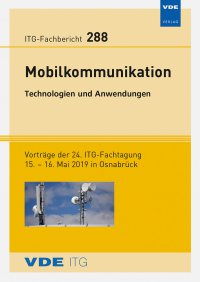Design of a 5G Ready and Reliable Architecture for the Smart Factory of the Future
Conference: Mobilkommunikation – Technologien und Anwendungen - 24. ITG-Fachtagung
05/15/2019 - 05/16/2019 at Osnabrück, Deutschland
Proceedings: Mobilkommunikation – Technologien und Anwendungen
Pages: 5Language: englishTyp: PDF
Personal VDE Members are entitled to a 10% discount on this title
Authors:
Strufe, Mathias; Gundall, Micheal (Intelligent Networks, German Research Institute for Artificial Intelligence GmbH (DFKI), Trippstadter Straße 122, 67663 Kaiserslautern, Germany)
Schotten, Hans D. (Intelligent Networks, German Research Institute for Artificial Intelligence GmbH (DFKI), Trippstadter Straße 122, 67663 Kaiserslautern, Germany & Institut for Wireless Communication and Navigation, University of Kaiserslautern (TUK), Gottlieb-Daimler-Straße 47, 67663 Kaiserslautern, Germany)
Markwart, Christian; Ganesan, Rakash SivaSiva (Nokia Bell Labs, Werinherstraße 91, 81541 Munich, Germany)
Abstract:
The increasing demands for highly individual products as well as for flexible production lines represent new challenges. To address these demands, future plants must be highly flexible and dynamically reconfigurable. Current systems are usually based on wired technologies for the connection of sensors, actuators, and controlling or monitoring devices that allow only very limited dynamics. New applications, such as the use of robots, drones, or reconfigurable production lines, require the exploitation of wireless communication technologies. However, current technologies are not able to meet the high requirements in terms of latency, robustness, resilience and data rate. The introduction of the 5th generation (5G) cellular communication system will meet these requirements for the first time. Besides the use of radio-based solutions in new plants - so-called greenfield scenarios - deploying 5G also represents an efficient migration of existing plants - so-called brownfield scenarios - to Industry 4.0. In order to ensure that the challenging requirements are indeed meet in practical deployments of the new 5G technology, a tailor-made architecture is being developed within the Tactile Internet 4.0 (TACNET 4.0) project. As a basis for the design of the architecture, representative Industry 4.0 application scenarios, which are also be considered by the 3rd Generation Partnership Project (3GPP), were analyzed and compliance with the latest developments in the relevant standardization is also our target. The paper gives an overview of the considered use cases as well as the relevant reference architectures and the design process of the TACNET 4.0 architecture.


